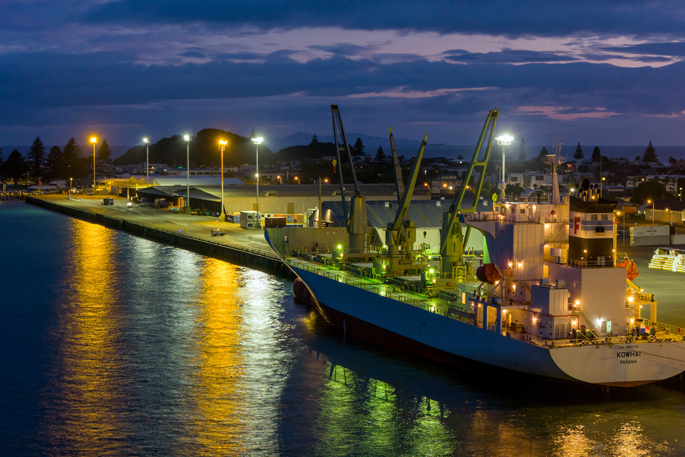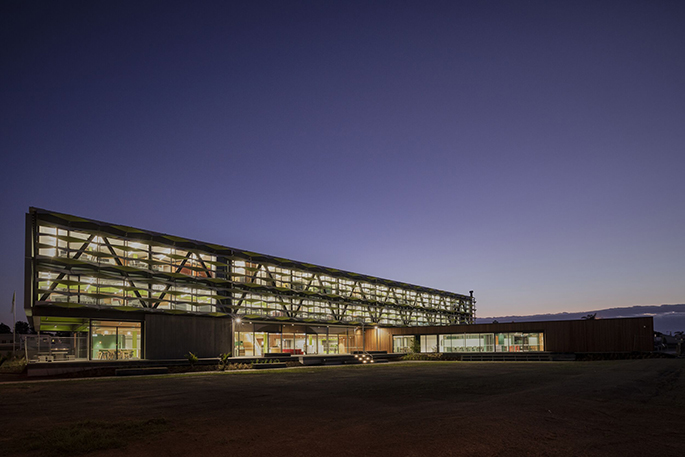Zespri and shipping partner ANL/CMA CGM are driving towards low-emissions international shipping with the launch of a feasibility study into corridor between New Zealand and Belgium.
Associate Transport Minister Matt Doocey hosted an event on Tuesday supporting the launch of a feasibility study into setting up a low-emissions shipping corridor between Tauranga and Zeebrugge in Belgium via the Panama Canal, commissioned by Zespri and one of its key shipping partners, ANL/CMA CGM.
Zespri Executive Officer Sustainability Rachel Depree said shipping plays a critical part in New Zealand’s export-driven economy, carrying 99 per cent of the country’s trade by volume and around 80 per cent by value.
“Low-emissions shipping is a critical part of carbon reduction for exporters and also underpins our collective ability to achieve the government’s goal of doubling export value over the next 10 years. Collectively we are already facing rising costs as carbon is priced into the economy and our markets and customers are starting to demand targets and plans to lower emissions over time.”
ANL & CMA CGM Oceania Managing Director Shane Walden outlined the efforts of the CMA CGM Group in decarbonising transport and logistics.
“The CMA CGM Group is a global player in sea, land, air and logistics solutions, and places the preservation of the environment at the heart of its strategy, with a commitment to reach Net Zero Carbon by 2050 across all its activities.
“In shipping, CMA CGM is focused on reducing energy consumption as well as using sustainable low-carbon energies where possible in order to accelerate the energy transition of the sector, including that of key customers such as Zespri.
“New Zealand is an important country for the CMA CGM Group. The country has a geographic advantage that, with support, could allow New Zealand to play a role as a maritime energy hub for the South Pacific.
“We embarked upon this project with Zespri and EY as it is imperative that we jointly address climate challenges in the sector to support New Zealand’s maritime trade.”
 Kiwifruit being loaded onto a ship in at the Port of Tauranga in March.Photo: Jamie Troughton/Dscribe Media.
Kiwifruit being loaded onto a ship in at the Port of Tauranga in March.Photo: Jamie Troughton/Dscribe Media.
Depree said shipping emissions are one of the key challenges to decarbonising the kiwifruit industry and meeting Zespri’s climate commitments.
“While kiwifruit is a low-carbon product, shipping emissions make up a larger portion of the product’s overall carbon footprint at 43 per cent - and that’s why action is a priority.
“Like many exporters, Zespri can’t directly reduce shipping emissions ourselves so we’re working with our shipping and distribution partners to improve efficiency and find opportunities to pilot low-emissions fuels solutions as we work towards our ambition of being carbon positive by 2035.
“This includes continuing to advocate for new port infrastructure and supporting the introduction of more low emissions shipping vessels, fuels and technology – all of which are critical and which require significant investment.
“The problem is significant and the answer complex but we do know success here will require coordinated action across government and supply chains,” said Depree.
 Zespri's office in Mount Maunganui. Photo: Sam Hartnett.
Zespri's office in Mount Maunganui. Photo: Sam Hartnett.
What did the report by EY find?
The report outlines the complexity of decarbonising shipping and what’s needed from all the players across the value chain from exporters to shipping companies, fuel companies, ports and governments, and confirms how varied and significant the change required is.
Key findings include:
- European ports are already making large investments to accept alternative fuel ships (which are larger than conventional vessels) and some are already running on 100 per cent renewable energy
- Collaboration with other New Zealand exporters and across the supply chain is critical to show demand, reduce cost and speed up investment. Shipping providers have started offering solutions to find the most cost-effective ways to transition to lower-emissions fuels
- Governments have an important part to play, with new policies and regulations needed to transition fuels and infrastructure, including supporting health & safety regulations
- Fuel storage requirements for low-emissions fuels will create new challenges, with lower emissions fuels being less energy dense and requiring a lot more space. This means larger vessels which require larger, deeper berths
- The outlook for alternative fuels is complex – there is no clear preferred low-emissions fuel so an adaptive and multi-fuel approach is needed.
What is a low-emissions/green shipping corridor?
A low-emissions shipping corridor is defined as ‘a route between two or more ports where zero-emission shipping solutions are demonstrated and reported’.
It is supported by the 2021 Clydebank Declaration – an agreement signed by 22 countries including New Zealand, Australia, Belgium, and the USA - to explore and develop partnerships among ports, operators, and other key partners along the value chain. The aim is to accelerate the decarbonisation of the shipping sector and its fuel supply through low-emissions shipping corridor projects, aligning with the global effort to combat climate change and transition towards a more sustainable future for the industry.
What did Zespri and ANL/CMA CGM learn from the report?
- Alternative fuels
- There’s no clear winner in the fuel race yet.
- Emission intensity of alternative fuels is dependent on how these are manufactured.
- Renewable energy is critical for upscaling alternative fuel production.
- Biofuel can provide a useful lower-emissions bridge as it can be “dropped in” to conventional vessels often with little or no modifications.
- Fuel cost
- Alternative fuels are expected to price-match fossil fuels by 2040 onwards, due to reducing renewable electricity cost, the removal of subsidies on fossil fuel and carbon taxes.
- First movers are needed to understand commercial production and economies of scale. In an uncertain regulatory environment, they must be supported by relevant agencies to overcome barriers and reduce investment risk.
- An effective emissions pricing mechanism is needed to make green fuel competitive with “black fuel” during the transition period.
- Ports & alternative fuel storage
- Ports need longer and deeper berths to accommodate low-emission ships. These ships are larger than fossil-fuelled ships as alternative fuel is not as energy dense and vessels need larger fuel tanks.
- Ports can become a key stakeholder in alternative fuel value chains, capitalising on the opportunity to become alternative fuel bunkering hubs.
- New storage infrastructure is needed to safely bunker alternative fuel.
- Storage will need to be almost twice the size for liquefied methane and more than four times greater for hydrogen to create the same energy.
- Policy and investment
- New Zealand trails other countries in climate and transport policy and investment for low emissions shipping.
- For example the port of Rotterdam currently has a terminal and bunkering for methanol, biofuels and LNG, a terminal for ammonia (with a feasibility study for bunkering) and small-scale bunkering for hydrogen.
- Customers
- Customers want low-emission shipping at a competitive cost to fossil fuels methods and are reluctant to pay a substantial green premium.



0 comments
Leave a Comment
You must be logged in to make a comment.